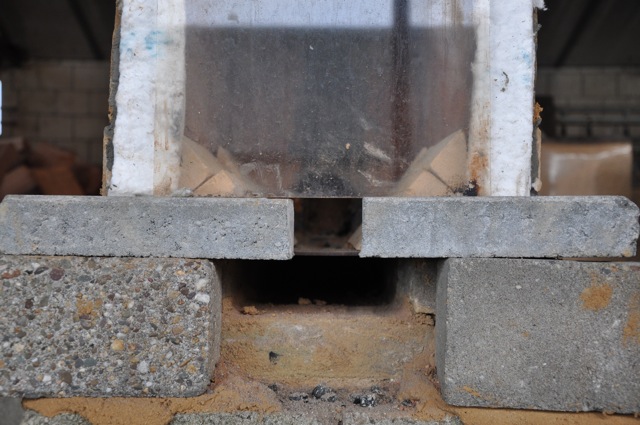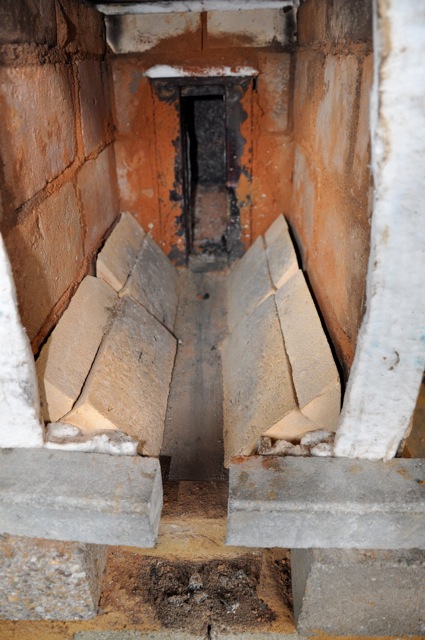|
|
Post by Robert on Dec 28, 2013 0:34:52 GMT -8
Its kind of confusing now. Its great idea, and i do not know if it can be used or not. Is it blocking us from experimenting and working on it since once somebody has shown his idea? It would benice to make a sketchup design for it.
And also i am looking at the readings from testo and i do not really see such an improvement. The one interesting thing is that with this setup i could get the air from outside more easily...
|
|
|
|
Post by pioniers on Dec 28, 2013 2:27:28 GMT -8
Hi DCish,
I will ask Peter to add a couple of pictures which will explain the way the secondary air is going to the S-portal.
The nice thing about this way of adding primary and secondary air so close to each other is that you can easily make a rude way of blocking all the air from entering the firebox with for example a piece of steel or stone
Sjang
|
|
|
|
Post by Robert on Dec 28, 2013 4:41:07 GMT -8
Dear pioners / Sjang.
I wanted welcome you on the forum. I heard about you few times and seen some pictures on the MHA site of one of your stove. Just for the short offtop i wanted to ask if there is a possibility that you could share some of your projects that you made? i am interested about using rocket core for cooktops and water heat exchangers for central heating systems.
And regarding your nice invention is there a possibilitty to make a sketchup design for this S-port thing?
|
|
|
|
Post by peterberg on Dec 28, 2013 8:15:23 GMT -8
 Front of the batch rocket, with the small hole underneath the glass being the primary air inlet then the steel plate on which the S-portal is mounted and then the big hole underneath being the secondary airinlet. Front of the batch rocket, with the small hole underneath the glass being the primary air inlet then the steel plate on which the S-portal is mounted and then the big hole underneath being the secondary airinlet. Here in the middle of the firebox floor the steel plate is visible on which the S-portal is mounted, and is also separating the secondary channel from the firebox. Here in the middle of the firebox floor the steel plate is visible on which the S-portal is mounted, and is also separating the secondary channel from the firebox.The flakes left and right of the port is clay which has been used as a seal between steel and brick. |
|
|
|
Post by peterberg on Dec 28, 2013 8:22:50 GMT -8
And also i am looking at the readings from testo and i do not really see such an improvement. The one interesting thing is that with this setup i could get the air from outside more easily... The most important change is the ability to run clean with much lower excess air. Creating a lean burn as it were, less air overhead is driving the efficiency up. |
|
|
|
Post by matthewwalker on Dec 28, 2013 9:23:22 GMT -8
Interesting, I wonder if the longer burn time was a result of the coals being cooled on the lower plate? I would think coal build up could be a problem there, but I'm sure there are pros and cons like all designs. Very cool, thanks for sharing Sjang and Peter.
|
|
|
|
Post by Robert on Dec 28, 2013 10:44:43 GMT -8
Thanks for the picture. I am thinking about durability of this solution. We know that the steel heatrisers are going to die sooner or later, so what about making this port from the steel. How long it will last? it would not be nice if after 3 - 4 years we ould have to replace it, which would be very difficult.
|
|
|
|
Post by Donkey on Dec 28, 2013 12:18:32 GMT -8
In this case, the steel bits have cool air channeled through them, they are cooled by the running of the stove and will last longer than you might think.
The steel on the floor might get overheated when the fire goes out and a big pile of coals sits on it.. Not sure about that, but maybe.
How very interesting.. Thank you once again peter, for sharing openly to the community, a commercial innovation.
|
|
|
|
Post by DCish on Dec 28, 2013 20:28:46 GMT -8
Thank you, Sjang and Peter!
Donkey, seems that the potential for a long-lived steel plate due to air flow cooling it would be confirmed by the reported longevity of current P-channels. But if that were a concern, the floor could be refractory and the S-portal air supply channel could run below it... at the expense of pre-heating. Trade-offs, trade-offs.
Also, I join Walker in his curiosity about the effect (if any) on the efficiency and/or completeness of burn at the coaling stage when heat is harvested from below.
|
|
|
|
Post by pioniers on Dec 30, 2013 12:44:49 GMT -8
There is still some work to do, also to find the answers to the above mentioned issues. Robert with respect to earlier projects, I am happy to share my experiences with them, my plan is to post the most interesting ones in the coming months on www.rocketstove.nl I would like to have this website packed with rocket projects and useful information, calculations etc, but it will take time. |
|
|
|
Post by peterberg on Dec 31, 2013 9:05:21 GMT -8
Thank you once again peter, for sharing openly to the community, a commercial innovation. Much obliged but... this one wasn't my doing. This portal is all Sjang's idea and (in time) I will do some testing. |
|
|
|
Post by Robert on Jan 4, 2014 9:10:48 GMT -8
There is still some work to do, also to find the answers to the above mentioned issues. Robert with respect to earlier projects, I am happy to share my experiences with them, my plan is to post the most interesting ones in the coming months on www.rocketstove.nl I would like to have this website packed with rocket projects and useful information, calculations etc, but it will take time. Hello Sjang. Nice to hear. I have been looking at your work on your NL version of the site, and also a little bit reading here and there about your projects. I would like to ask you also if it is possible, please share some of your knowledge and experience here on a forum. you know so much and you have such a nice experience. Since i am from Poland and here not so many ppl know about rockets, i have only a chance to learn from such a nice pros like you and few folks here. I have seen that you will be leading a workshop in UK on a cookstove with water heating. I am so much intersted in that design. If you could please start a thread and show some of the pictures i would be soooooo gratefull for that. And i kinda like some old of your small cooking baby that i have seen on your site. It looks awesome, wanted to ask so many questions. This is the one i am talking about: ![]()  So once again i wanted to say that i admire your job, and please, join our forum and share some of your experience. I am kind of sure that we all can learn from each other. Robert. |
|
|
|
Post by talltuk on Jan 7, 2014 13:33:13 GMT -8
Hi sjang. Nice looking idea, definitely gonna try this out on my experimental build, when I get acess to metal working anyway. It was mentioned you are running a workshop In the UK. Do you have any details as I would be really interested but cant find details on your site.
|
|
|
|
Post by Robert on Jan 8, 2014 3:58:41 GMT -8
Hey. here is the link to the above mentioned workshop. if you get so lucky and will be there, please ask Sjang to allow making a documentation. i would like to see how it will be made. especially i am interested in a heat exchanger for central heating  www.vuurenleem.nl/leemkachel/rocket-stove/workshops#engeland www.vuurenleem.nl/leemkachel/rocket-stove/workshops#engelandPlaats: Cooksbridge, UK Datum: 14 -16 februari 2014 Kosten: € 295,- plus reis op eigen gelegenheid. Deelnemers: min. 5 - max. 7 In dit kleine huis hebben de eigenaren specifiek voor een Rocket gekozen vanwege zijn efficiëntie. Het huis is onderverdeeld in kleine kamers en is daardoor minder geschikt voor een standaard leemkachel. We gaan een kleine Rocket Mass heater bouwen met een cooker en een verwarmde bank, plus een warmtewisselaar naar de CV-installatie. Zo kan de Rocket toch het hele huis verwarmen. Zonnecollectoren zijn al aangesloten op dit systeem, dus als de Rocket op zijn plek staat kan men ook hier genieten van vier seizoenen warmte uit hout en zon. In this small house, the owners have chosen specifically for a Rocket because of its efficiency. The house is subdivided in small rooms, which doesn't make it suitable for a standard masonry heater. We will build a small Rocket Mass Heater with a cooker and a heated bench, plus a heat exchanger for the central heating system. In this way, the Rocket can heat the whole house. Solar collectors are already connected to this central heating system, so when the Rocket is in place, the people in this house willenjoy heating from wood and sun throughout the four seasons. |
|
|
|
Post by doggy1969bc on Jan 9, 2014 13:33:15 GMT -8
pyrophile Avatar Dec 25, 2013 20:33:05 GMT 1 pyrophile said: As I said I just give an opinion without any agressiveness. It was, for me, a kind of respect for all the work done by you, Peter. The other reason was that I had the same idea and I am not found about property rights with open source ideas. To come back to Pioniers's idea, one of the interests (I think) is that the depression -then the air sucking- is stronger at this place. It is even stronger after the slot but there it is a bit less simple. ![]() Benoit Could it be done with round piping and a couple of 90° couplings ,make a slip in the piping so you can direct the airflow comming out of it and put it in the zone were the pressure is the lowest just after the smallest part of the portal , put a pipe in the burn chambre to a "T" for the incoming secondary air .Then you dont have to chamge your fire box much ,just narrow the airinlet. Greatings doggy |
|